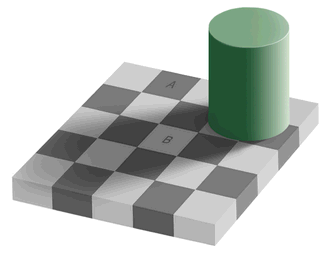 In The God Delusion, Richard Dawkins argues that God (probably) does not exist, and he associates belief in God with the childhood practice of having an “imaginary friend” (Dawkins 2006, p. 88). He advocates, as an alternative to belief in God, using science and evidence to develop useful models that replicate how the world works.
In The God Delusion, Richard Dawkins argues that God (probably) does not exist, and he associates belief in God with the childhood practice of having an “imaginary friend” (Dawkins 2006, p. 88). He advocates, as an alternative to belief in God, using science and evidence to develop useful models that replicate how the world works.
Although his argument has some validity, it is underpinned by a Western cultural premise that something is either real/exists or imaginary/unreal. This is a false dichotomy, created by the tendency in the modern Western mind to think in terms of simple opposites (Corbin 1972, p. 1). Imagination and reality are not alternatives, but imagination helps to create reality. This can be illustrated with three practical examples.
Illustration 1: Optical Illusion
In the picture above/right (published by Edward Adelson on a Wikipedia page), squares A and B are opposite colours – one is black the other is white. Can you see how this reality is created by your imagination?
When you look at the squares, you are not dealing with one reality but two, and they seem to conflict. The two squares are opposite colours, black and white, but on the screen the colours of the two squares are identical. This is shown by the animation.
 The reason that you see opposite colours rather than identical squares is because your imagination interprets the context in which they appear. You imagine you are looking at a checkered board, partially shaded by a cylinder, so you expect the squares to be opposite colours. In this case, the reality you notice first is the imagined checkerboard (with a high contrast in colours) rather than the scientific reality (identical colours).
The reason that you see opposite colours rather than identical squares is because your imagination interprets the context in which they appear. You imagine you are looking at a checkered board, partially shaded by a cylinder, so you expect the squares to be opposite colours. In this case, the reality you notice first is the imagined checkerboard (with a high contrast in colours) rather than the scientific reality (identical colours).
Illustration 2: The Colour Green
 Colour was a favourite metaphor of C.G Jung and he often gave green as an example (e.g. Jung 1943, p. 218). The colour green does not have an independent existence in the world, it is co-constructed by the world and the mind. What exists in the world is a particular wavelength, which most people in most contexts see as green.
Colour was a favourite metaphor of C.G Jung and he often gave green as an example (e.g. Jung 1943, p. 218). The colour green does not have an independent existence in the world, it is co-constructed by the world and the mind. What exists in the world is a particular wavelength, which most people in most contexts see as green.
Again, there are two different types of reality involved in this illustration: the wavelength that is in the world; and the colour green that is co-created by one’s imagination and the wavelength. In this case, both realities have practical applications. For example, wavelengths are used to build special heat-sensitive cameras to find people at night or who are lost at sea. Colours are used in traffic lights to help us drive safely through busy road junctions.
Illustration 3: Imaginary Numbers
C.G. Jung also drew a parallel with imaginary numbers in mathematics (e.g. Jung 1943, p.80fn or Jung 1916, p. 69). The imaginary unit (usually denoted by the letter “i“) is the square root of minus one – that is, i 2 = -1. It is not a real number, because when a real number is multiplied by itself the result is always positive (or zero).
Imaginary numbers are widely used in fields such as physics, electronics, and quantum mechanics. Aeroplanes depend on imaginary numbers in their control systems – without them, modern aeroplanes would not be able to fly:
The name “imaginary number” was coined in the 17th century as a derogatory term, as such numbers were regarded by some as fictitious or useless, but imaginary numbers are no more or less fictitious than any other kind of number. (http://en.wikipedia.org/wiki/Imaginary_number)
Although imaginary numbers are not “real numbers”, they are still real – i.e. they have their own type of reality, which is different to that of real numbers. If this seems confusing, it is probably because you are used to thinking in terms of opposites, i.e. the Western false dichotomy that something is either imaginary or real. It might make more sense if you think in terms of there being many different types of reality, all of which are imagined.
Imaginal relationships
In analytical psychology, everything we perceive is both imaginal and real, and imagination plays an active role in everything we think and do. Any distinction one might try to draw between real and imaginary is “irrelevant” (Jung 1939, p. 544) because everything of which we are conscious is “an image and an imagining” (Ibid).
Imagination plays a greater role in relationships than in the perception of objects. This is because there is less external evidence to help us shape our image of people than there is to shape our perception of objects. Our image of other people is therefore more malleable and subjective. Although there is a close (but not identical) correspondence between green and wavelength, we do not see other people so much as they actually are, but rather as we imagine them to be:
Everyone creates for himself a series of more or less imaginary relationships based essentially on projection. (Jung 1948, p. 264)
This principle can be seen at work in politics, where the description of political leaders often depends on who is doing the describing. Members of the same political party usually see the leader in a much more positive light than members of opposing parties. When evidence emerges to show that someone is very different from who we imagine them to be, this can be a cause of relationship breakdown.
Imaginal science
Imagination plays a central role in science. Karl Popper, a leading philosopher of science, described the continuous improvement of scientific knowledge as consisting of a repeating cycle of two stages, imagination and reflection:
The task of science [has] two different components… The first is [is] myth-making: the invention of stories that explain the world… The second [is] the critical discussion of the various explanatory myths – with the aim of consciously improving upon them. (Popper 1963, p. 40)
For Popper, both religion and science rely on imagination and are therefore ‘myth’. N.B.: Popper does not use the word myth to mean falsehood (a Western interpretation based on a false dichotomy). Rather he uses the word myth to describe a product of the imagination.
In Popper’s view, what differentiates science from religion is the second stage – reflection. Scientific reflection seeks to discuss one’s beliefs critically and improve scientific knowledge. Much religious reflection is dogmatic, adhering to original beliefs even in the face of contradictory evidence. However, there are forms of religious or spiritual reflection that regard God’s nature as a mystery and seek to improve one’s image of God in the light of evidence and experience.
The Imaginal God
Just as imagination is central to our perception of and relationship with the world and other people, it is also central to our knowledge and relation with God. We don’t see spiritual reality directly, but as we imagine it to be. This imagined image of God has a reality of its own and is the primary spiritual reality with which we have to deal.
When Richard Dawkins likens God to an imaginary friend, he has a valid point to some degree. However, this anthropomorphisation (i.e. imagining God has human qualities) is not to be disparaged as childish because imagination is a central part of everything we do. It becomes problematic only if we refuse (as Dawkins suggests) to revise our image of God in the light of evidence and experience. Having a faith means to place our trust in something that we cannot see. However, if we doggedly adhere to an image of God in the face of contradictory evidence that we can see, this is not faith but foolish obstinacy.
Does God Exist?
The imaginal nature of the world we live in renders the question Does God exist? somewhat pointless and misleading. It is rooted in a literalism that carries with it several tacit and invalid assumptions, e.g. that:
- there is only one form of reality;
- we all share the same image of God;
- the images we have of God are identical to external spiritual reality;
- God is either imagined or real, but not both.
Also, the question Does God exist? solicits an over-simplistic ‘yes’ or ‘no’ answer that polarises debate. The ‘yes’ camp then have to defend fixed beliefs, even in the face of contradictory evidence, and the ‘no’ camp lose all connection with any spiritual reality.
A more useful question might be to ask What does God represent? – whilst recognising that our images of God contain some subjectivity (both individual and cultural) and objectivity (an external spiritual reality). This question is symbolic rather than literal, and leads to acceptance of a wider range of answers.
For some people God might represent an omniscient, omnipotent, omnipresent, and supernatural being who sometimes decides to intervene in human affairs. For others (such as Jung), God represents a transcendent, spiritual mystery who, although powerful, is not limitless in his capabilities. For yet others, God represents the natural laws that keep order in the universe. Each of these images is co-created by a spiritual reality and our individual/cultural imaginings.
Practical Implications
Analytical psychology challenges us to think differently about God, and this new mode of thought can be very hard to fathom. It suggests we move from thinking literally – i.e. that our images are identical with an external reality – to thinking symbolically – i.e. that the images represent multiple forms of reality. It suggests we move from thinking about the opposites, of imaginary and real, to thinking in terms of our imagination co-creating reality. And it calls us to accept that our image of God is, at least in part, subjective and therefore contains some projections from our own personalities and culture.
In our contemplation and relationship with God, we cannot eliminate imagination, because our image of God is co-created by our imaginations and spiritual reality. However, we can improve our image of God, and transform our spiritual lives, by cultivating a spiritual imagination (Corbin 1972, pp. 9-12) and by being prepared to change our image of God in the light of evidence and experience.
References
Corbin, H. (1972), Mundus Imaginalis or the Imaginary and the Imaginal, (http://www.scribd.com/doc/21749897/MUNDUS-IMAGINALIS)
Dawkins, R. (2006), The God Delusion, (London: Bantam Press)
Jung, C.G. (1916), The Transcendent Function, in Collected Works 8, (London: Routledge, 1969)
Jung, C.G. (1939), Foreword to Introduction to Zen Buddhism, in Collected Works 11, (Hove: Routledge, 1969)
Jung, C.G. (1943), Two Essays on Analytical Psychology (7th Edition), Collected Works 7, (Princeton: Bollingen Paperbacks, 1972)
Jung, C.G. (1948), General Aspects of Dream Psychology, in Collected Works 8, (London: Routledge, 1969)
Popper, K.R. (1998), The World of Parmenides, (London: Routledge)
